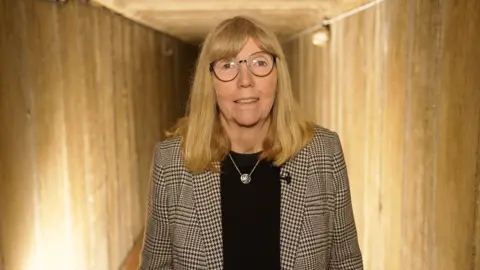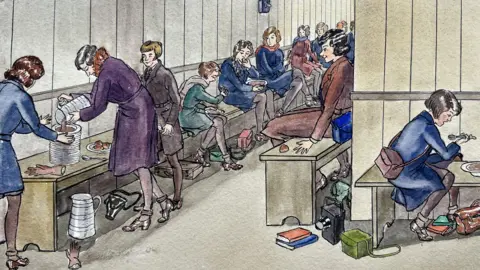The underground school tunnels used during WW2
 Andrew Marshall/BBC
Andrew Marshall/BBCIn the shadow of Maidstone Grammar School for Girls sits a set of concrete steps built into a grassy mound.
It's the only clue to the extraordinary wartime legacy that lies below the ground here.
Former head teacher Mary Smith leads the way down the steps and through a set of steel doors to reveal the extraordinary scene recently rediscovered by surveyors - a zig-zag network of underground tunnels that served as subterranean classrooms – bomb shelters that became school rooms throughout World War Two.
"When we opened them up, we didn't know they were going to be in such good condition," said Mrs Smith.
"When we came down here we were astonished to find they were almost exactly the same as they were during the war."
There are benches up against both sides of the narrow tunnels that served as seating for the classes that took place here.
The walls are cold and damp, the tunnels lit by a single electric light.
Mrs Smith said: "When the air raid siren sounded the girls in class were told to be immediately silent and then they would stand up and leave the school in single file."
 Andrew Marshall/BBC
Andrew Marshall/BBCMrs Smith said: "They came down the steps into the tunnels and then it was books on laps and the lesson would continue from where they had left off in the classroom.
"There were six of these tunnels so there would have been six classes with 30 children in each, so 180 children in total."
They were created in a zig-zag formation in an attempt to limit blast damage should a bomb land nearby.
Shovels and picks were also left in the tunnels should the girls ever need to dig themselves out.
Former wartime pupil Inga Mayor, 94, said: "You would be sat down here and be chatting but aware all the time that you could hear enemy planes.
"There was camaraderie of course. War brings that doesn't it? Danger brings that.
"We somehow felt safe down here."
 Maidstone Grammar School for Girls
Maidstone Grammar School for GirlsVicky Milsted, 92, who was also a pupil here, said: "It didn't matter where you were, you picked up your dinner and you went down to the shelter.
"To start with it was very frightening. Until then the war had been over there in London."
The school's war-time art teacher Helen Keen captured the reality of life in a series of paintings which she included in a war diary.
Her watercolours include pictures of staff running into the tunnels, and of lessons continuing underground.


Ms Keen also painted pictures of the staff on VE Day as they removed splinter netting from the school's windows.
Current headteacher Deborah Stanley said: "They were absolutely determined that they were going to carry on with their education.
"That was the mantra of the headteacher at the time, that the girls' education was not going to be diminished by a national crisis, they were still going to get the best possible education they could during their time at the school."
Follow BBC Kent on Facebook, on X, and on Instagram. Send your story ideas to [email protected] or WhatsApp us on 08081 002250.
